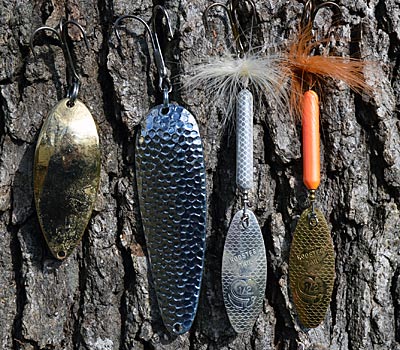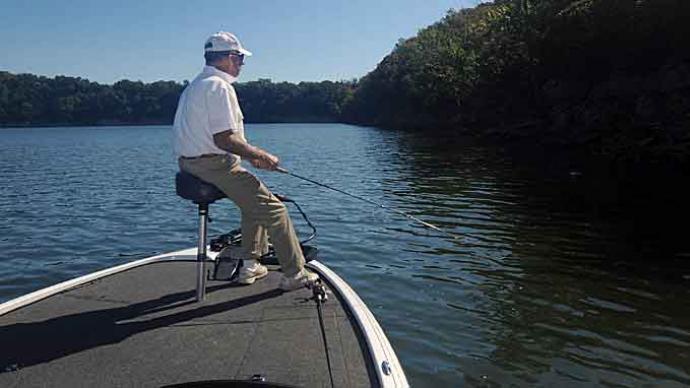
Beginning anglers benefit from wide-open waters, especially when it comes to lure selection. They haven’t built up biases or memories, so they don’t feel limited by unwritten rules that connect specific lures to certain fish species. If it looks good, they fish it.
But as time goes on and anglers collect experiences on and off the water, many begin discounting specific lures for bass fishing, believing, for example, that a lure only catches walleye or trout. And unfortunately, that’s a mistake. Sometimes the key to catching more bass is straying outside the lines that labels create.
Lures are tools. And if they match the size, action, and color of what bass are eating, those bass will eat them, too. That’s the case for these five lures, which many anglers closely associate with certain fish. But by understanding and tapping their potential, you can catch bass with them, too.
-
Inline spinners
There are good reasons that inline spinners are one of the first lures that anglers purchase. To begin with, they are easy to use and catch everything that swims. But don’t let their universal appeal keep you from applying them to specific bass fishing situations.
Inline spinners produce a lot of flash and vibration from a compact body. That helps in pressured waters, where bass likely shy from larger profile spinnerbaits. They shine on windy days when their size makes casting easier, and they can be quickly retrieved below the surface without worrying about blowing out.
Consider two variables when choosing an inline spinner. Weight determines how far it will cast and how deep it can be fished. Secondly, match the blade size to the baitfish the bass are eating. Color choices are endless, so choose one that best matches the conditions.
Hook dressings are a tossup: Some anglers swear by them, and an almost equal number say a bare treble hook is just as productive. They surely help when a larger silhouette is needed. Adding marabou, squirrel, or deer hair to the treble hook doubles a spinner’s size. And that can help draw strikes from larger bass.
Inline spinners can’t be fished everywhere. With a free-swinging treble hook, they aren’t as weedless as spinnerbaits. The blade, especially longer ones like those on Yakima’s Rooster Tails, will deflect some snags. But aquatic vegetation and branches on laydowns will pose issues.
-
Glide baits
The anticipation of a strike is one of fishing’s great joys. You rarely can precisely predict when one will happen, but the arrival re-establishes your devotion to the sport. Specific lures and techniques, such as topwaters and sight fishing, give you a front-row seat to strikes. You can add glide baits to that group, too.
Baitfish-shaped and slow sinking, glide baits move side to side underwater, similar to how a walking bait moves across the surface. Most are used by musky anglers, many of whom fish them from early spring through late fall. They’ve made their biggest bass-fishing splash with hardcore lunker hunters. But that doesn’t mean you shouldn’t try them when seeking a limit in your local bass tournament or enjoying an evening on your favorite lake.
Most glide baits designed for muskies will catch bass, especially those between 4 and 8 inches long. They are available much larger — more than 1 foot — if you want a true bass of a lifetime. There is a growing selection of glide baits specifically designed for bass. Most are built by Japanese lure manufacturers and have hefty price tags.
While most anglers fish glide baits within a couple of feet of the surface, where they can see them, they’ll produce as deep as you’re willing to wait for them to sink. They walk farther to each side as you add more power to each twitch and patience to each pause. The key is giving them enough slack, created by immediately pushing your rod’s tip back toward the lure after each twitch.
Don’t get caught collecting every glide bait that’s made in every color. Instead, stick to the one whose size and weight are easiest for you to swim. And stock your tackle box with two colors, a bright one for dark water and low-light conditions and a more natural baitfish pattern for when the sun shines, and the water is clear.
Most glide baits weigh 1 ounce or more, so you’ll need beefy gear. Swimbait rods are a good choice, as they are the lightest musky rods you can find. Spool up with at least 50-pound test braided line, whose lack of stretch transmits every bit of twitch. Tie in a leader of fluorocarbon line, 15-pound test or stronger. Its stiffness will keep your line in front of your lure and not tangled in its hooks.
Image
Primarily used for salmon, trout, and northern pike fishing, spoons and inline spinners deserve a spot in every bass angler’s tackle box. Heavy and compact, they are easy to cast and give pressured bass a different look, especially when eating baitfish. Photo by Pete M. Anderson -
Spoons
Bass fishing claims its fair share of spoons. There are jigging spoons, the metal slabs hopped along the bottom, and weedless spoons, such as the Johnson Silver Minnow, which slither through cover. And there are large structure spoons, which measure upwards of 8 inches and are pulled and dropped across deep-water structure for summertime bass.
But there is an open niche for spoons between 2 to 4 inches in length, most often used for trout, salmon, and northern pike. Oblong and concave, they wobble and flash when retrieved. They pack a lot of weight in a small package, so they can easily fish at any depth or distance, which is essential when chasing schooling bass. They are an excellent alternative anywhere you would fish a jerkbait, spinnerbait, or crankbait.
A spoon’s shape determines its wobble. Narrow spoons have a tight action, allowing them to be retrieved fast. Wider spoons produce a pronounced thump, which slows their retrieval speed. Color choices are varied, with simple polished silver, gold, and copper producing flashes that resemble baitfish. Try a hammered one in low light or stained water; its dimples reflect more light.
Upgrade your spoon’s stock treble hook with a round-bend one that’s a size larger. Both will help you catch bass that only swat at your spoon. And add a swivel — ball-bearing models operate the smoothest — to the front of your spoon. It eliminates line twists.
-
Ice jigs
Most bass anglers won’t stop to look at ice-fishing gear. Small and fished vertically, not much transfers to the run-and-gun style of fishing open water. Two professional anglers have one reason to give it a second look.
Rapala’s Jigging Rap is oddly shaped — a cylindrical body with a line tie on top, a small treble on the bottom, a single hook at one end, and another next to a small plastic bill on the other. It and other similar ice jigs, such as Moonshine Lures’ Shiver Minnow, are mainly used to chase walleye and perch through the ice. But in recent years, some anglers have started using them in open water. Some of that effort has been focused on bass, most noticeably in February 2017, when Major League Fishing angler Jacob Wheeler used a Jigging Rap to catch some of the bass he weighed at the Bassmaster Elite Series tournament on Tennessee’s Lake Cherokee, which he won.
Fellow Major League Fishing angler Dave Lefebre is familiar with ice jigs, too. Living in northwestern Pennsylvania, he’s sent his fair share through the ice. But since his bass club days in the 1990s, he’s used them for bass, starting with smallmouth from ice-free Lake Erie.
Lefebre fishes them vertically in open water, like he would a jigging spoon, and most often in cold water. He doesn’t move much, less than 1 foot up and down, regardless of whether the bass are suspended or on the bottom. Sometimes, he said, bass will hit them while they sit motionless. They are offered in various colors and sizes, making it easy to match the hatch.
Ice jigs can be fished in other ways, too. Lefebre said they are an interesting choice for schooling bass because they can be cast far and worked quickly to entice reaction strikes. But the most beautiful thing about them is that most bass, especially those swimming south of the ice-fishing belt, have never seen one.
Image
When pressure or prey size makes bass challenging to catch, downsize to a panfish jig. Bass have a hard time resisting the tiny morsels, which demand patience on your part to fish—photo by Pete M. Anderson. -
Panfish jigs
When the fishing gets tough, the tough usually retreat to smaller finesse offerings — small worms, grubs, and other soft plastics. Sometimes they use jigs. While ones made for panfish may appear too small at first glance, they can produce big under the right conditions.
Panfish jigs are made in many shapes, sizes, and colors like their larger bass jig cousins. The two best for bass fishing are a marabou and a tube. You won’t need to go beyond the 1/8- or 1/16-ounce sizes, which are less than 2 inches long. Stick to a simple color selection, too. White, chartreuse and brown or green pumpkin are all you need to start.
Save these tiny jigs for a few special situations. They work well on bass under intense fishing pressure, such as swimming in small urban ponds and rivers. They perfectly match the hatch when bass are entirely focused on small baitfish. And try them in early spring, when bass, especially smallmouth, first move into shallow water. In each of these situations, you’ll want clear shallow water. Those give bass the best chance to see your jig.
Fish these jigs slowly. A little breeze or current will make staying in contact with one tough. Using light lines such as 4- or 6-pound test monofilament or fluorocarbon is easier. But don’t let its size stop you from fishing them in cover. They work best around docks, rocks, and aquatic vegetation.
The hooks in these small jigs aren’t the biggest or strongest. So, use a slower action rod featuring a blank that bends half to two-thirds of the way down and a correctly set drag on your reel. Add some patience and resist the urge to attempt a boat flip, and you’ll land almost all the bass you hook on one.




